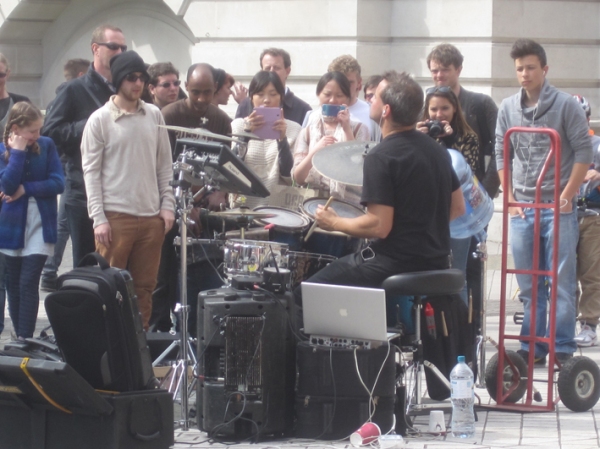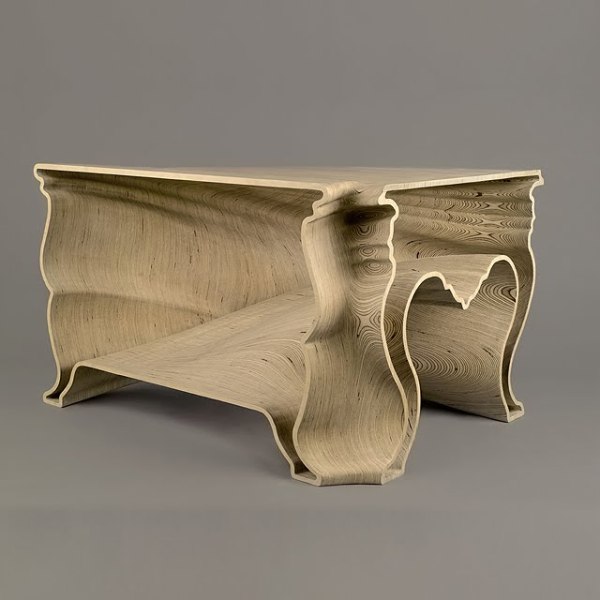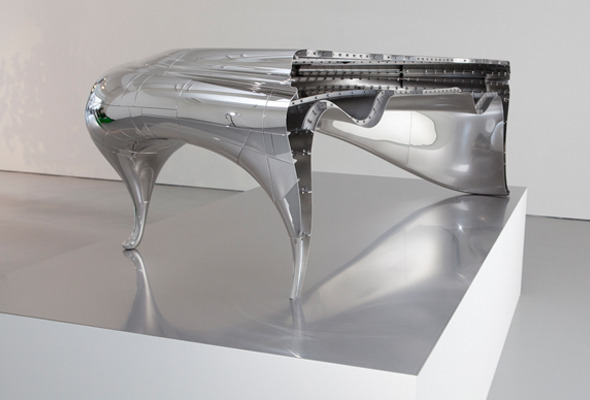3D guns
This is a piece from the BBC about the technical flaws and basic non-functionality of 3D printed guns.
3D printed guns “of no use to anyone”: http://www.bbc.co.uk/news/technology-27634626
The Victoria & Albert Museum should have thought about this before buying a 3D gun from Defence Distributed last September. It is a museum of art and design after all, and if an object is neither aesthetically nor functionally interesting why does it belong in the museum?
English Magic or English Politics
Would William Morris, the famous Victorian design reformist, do this to Roman Abramovich’s yacht?
This question has been on my mind ever since I seen the publicity for Jeremy Deller’s exhibition English Magic (first presented in the Venice Bienalle 2013, now on its UK tour). It was even more pressing as I stood before the mural at the William Morris Gallery last month. In the mural we are asked to believe that Morris would want to dump the yacht into the Laguna Veneta. But this representation of Morris’s ire seems to forget that Morris himself often relied upon the wealth of rich patrons. Of course, the breed of super-wealthy Russian oligarchs might not go in for Honeysuckle pattern curtains or Sussex chairs, but it is important to remember that Morris needed the support of the wealthy bohemians of late nineteenth century London to keep going in hard times. Moreover, there might be some fine examples of luxury craft onboard Abramovich’s yacht, a handcrafted item saturated with skill, something like Jereon Verhoeven’s super-bling, precision Cinderella table perhaps (that markets in the region of 75,000 – 100,000 euros)
The work of Jeremy Deller seems faulty when it deviates towards a clear political polemic, as presented in ‘We sit starving amongst our gold’ and other works of English Magic. For example the portraits from the inmates of Her Majesty Prisons all depict the main actors of the 2003 controversy about the ‘sexed up’ Iraq dossier (‘You have the watches, we have the time’ 2003), and the mural of a burning St Helier in Jersey (‘I want to be invisible’ 2017) and placement Morris’ socialist tracts alongside the ephemera that accompanied the scramble for minerals after the break-up of the Soviet Union, seemed too straightforward, too adversarial.
Deller’s performances, installations, and interventions strike a greater chord when they delve into the ambiguity of the carnivalesque or festival: as seen in the march in Manchester (Procession 2009); Sacrilege (2012) – a huge bouncy castle replica of Stonehenge; inviting the Melodians Steel Orchestra into the opening of this exhibition; or in the famous Battle of Orgreave (2001) where Deller initiated something that was well beyond his ability to control. His 2001 Folk Archive also celebrates the everyday acts of creativity that are hard to classify and completely ephemeral. Even in the design of the fake banknotes, tokens and promisary notes used in the 1990s scramble for influence in Russia’s lucrative minerals market, we see hints of folkish play: the graphics failing spectacularly to convince in their attempt to be official and convincing.
In the room containing ‘We sit starving amongst our gold’ visitors could take home a scaled down replica of the Morris mural, because, as Deller states “Everyone loves taking a piece of art home.” It had been rendered as a rubber stamp, a much more efficient form of printing-for-souvenir technology than the lengthy woodblock processes Morris developed in the late nineteenth century (as shown in one of the museum’s other rooms.)
There is a danger of conflating Morris with a family-friendly, participation-heavy, open atmosphere as the William Morris Gallery exhibition of Deller’s work does. It is too similar to the general positive vibe that so often is wed to the ideas of craft, in opposition to ugly industry; or good, moral behaviour as opposed the excess and vacuousness of Abramovic.
Morris’s politics (and aesthetics) more complex than that. It is a very particular type of socialism, part Marx, part Victorian, full of rich contradictions that are well worthy of teasing out more fully than done here.
Documents on Contemporary Craft
Recent articles in other websites
I have done some recent writing for other websites. Please click on the following links:
3-D Printing: Hot Air? Art Jewelry Forum
The Amateur State Either/And (website set up by the National Media Museum)
Enjoy the Christmas period, the peace in your inbox, and good company.
Talks in mid-November. Epsom and Proto-Tools
I will be giving a talk in Epsom about female art education in Surrey (1890-1920) on Tuesday 12th November.
For more information see here.
I am also involved in a panel discussion with several artists at Flat Time House, Bellenden Road, Peckham on Sunday 17th November, 2-5pm
Let performers perform!
On Sunday 21st April 2013 Keith Harrison the Ceramics Resident of the V&A (from October 2012 – March 2013) gave a once-in-a-lifetime performance. Harrison had made a drum kit replica of the one Keith Moon of The Who blew up whilst performing ‘My Generation’ in 1967. Then, in homage to the rock star, he proceeded to crash about with the ceramic in front of the live audience.
Watching clay crash in front of your eyes has an undeniable appeal. The Greek restauranteurs in Paris’s Latin Quarter seem to think it does the trick in attracting diners. Nothing like starting a dining experience by stepping over a pile of cracked white plates. Yet when Harrison, dressed in a lab suit, got on to the grey dais bedecked with his ceramic drum kit my heart was not beating with expectation. This was primarily because of the amount of protective gear both on the stage and on my face: the V&A’s Health and Safety executive was clearly doing overtime.
Harrison started by putting on the music and stood for a while behind the drum kit, head bowed, like a scientist saying a prayer before an experiment. Then the music kicked in and he started smashing the symbols with his drum sticks and threw the drums on to the floor. A small explosion of two drums ended the performance, leaving the audience to give a mottled applause (for an edited video see here). The performance was short, undramatic, and a little juvenile. Even the material seemed to work against Harrison: this was not the wonderful high-fired glazed plate that smashes with such aplomb and brilliant sound in the aforementioned Parisian restaurants but the dull thud of biscuit fired terracotta (or the like).
There is, of course, an illustrious history of artists performing rather than just making objects – from the happenings of the 1960s in New York to Rirkrit Tiranvanija turning galleries into canteens. The problem with this earnest intention to re-jig what a gallery is, stretch its possibilities, or appeal to a wider audience, can be summed up in one ungainly word: miscontextualisation.
At the Harrison performance the audience sat down in rows in one of the V&A’s lecture theatres and were kitted up with goggles and safety glasses. Set-up as a passive audience waiting to watch, we were geared up to expect something dramatic or worthy of our passiveness: an entertaining film, informative lecture, or a conference-type panel discussion. You perform: we watch and judge.
The problem was that Harrison’s performance was underwhelming, and this brings in a second problem to do with miscontextualisation: competition. As a music performance piece this fared badly when compared to other forms of musical performance that we encounter in our lives: the live concerts, virtuosity at classical music halls, and various spectacle that are ever-present. Why spend time watching drum performances in a gallery when clubs, bars, and jazz venues do it so much better.
And then, as we left the V&A, as if an answer to my dissatisfaction, I witnessed an enthusiastic drummer entertaining the crowds on Exhibition Road.
Instead of a network of email circulars and invitations that were sent in advance by the V&A to ensure an audience at Harrison’s Moon performance, this guy drew an audience of passers-by. They were all enthralled and he was playing loudly, as if in battle with the noise of the street. Now that is what I called a performance. He arrested individuals from their everyday. But most importantly the audiences could do what they wanted, watch how they wanted, and did not have to wear ridiculous protective gear.
Bravo and encore to this man. He’s been seen south of the river too, in Brixton. Have a look at this youtube link for a taste of this man’s beats (and dancing).
Events in Contemporary Crafts
Two upcoming events on craftsmanship, making and contemporary art and design:
On 21 November Norwegian Crafts are running an international seminar on the place of craftsmanship in contemporary paradigms of making entitled ‘Very Good’.
http://www.norwegiancrafts.no/whats-on/international-seminar-very-good/577
Later on, on December 2nd at the Royal College of Art, there is the primary annual lecture on contemporary craft in the UK – the Peter Dormer Lecture. This year it is given by Martina Margetts, former editor of Crafts Magazine and a prominent figure within the culture of research and the Royal College of Art. Book your place to the event here:
http://www.eventbrite.co.uk/contact-organizer?eid=8735687677
More information about the lecture series is here:
The realm of the super-object
On Tuesday 19th September an audience that assembled in the central London gallery Blain Southern, witnessed an passionate defence of high-end craftsmanship. Jereon Verhoeven, and his brother – of Cinderella table (see below) fame were in conversation with Glenn Adamson, soon to be director of the Museum of Art and Design.
If the furniture of Verhoeven does not speak loudly enough – of bespoke craft, ingenious design, simplicity, of skills of making pushed to the limit – then they will do so themselves in person. This is what Verhoeven considered himself to be: a communicator of narratives.
And what narratives. Adamson elicited many tales from the duo all about the extremely difficult processes that they employ: how they convince their collaborators – the welders, CAD technicians, woodworkers, and indeed clients – to push the limits of their skill and go into the unknown.
This is certainly a return to the rococo elegance of Louis XIV, or the exuberance and folly of the 1851 Great Exhibition. Craft skill is pushed to the limit to stun and amaze an audience. The makers are directed by the Verhoevens who have the all encompassing vision. But don’t worry, this is not an instance of Damian Hirst or Anish Kapoor. The Verhoevens make a point of accrediting each maker and beamed with Dutch smiles when recalling how proud their collaborators were in contributing to their projects once finished.
The Verhoevens seemed to want to set the clock back. To revive a time when the rich of the world bought its most incredibly crafted objects. Verhoeven bemoaned the Roman Abramovich-esque selection technique for buying luxury yachts where the undiscerning buyer just picks the most expensive model. Better, Verhoeven claimed, for this wealth to go towards projects that test the limits of every craft involved in making something. A return to the glory days of the hand-crafted intricate royal carts, outsized technically impossible ceramics and uber-skilled diamond setting.
Two key words: limitations and tolerance. For the Verhoevens it is all about testing how far they can stretch the first, and how narrow they can make the second. Pushing the boundaries so that nothing can be even 0.1mm off.
This is the realm of the super-object, the superlative, “the most beautiful”. They loved the idea of craftsmanship in and of itself (with no regard of finance and time, and a combative relationship with materials that they want to push to the limits). So much so that they would go to a fine bar and see an incredibly skilled cocktail maker produce a drink, only to leave the drink aside once its served and pay for another one, so they can see the magic wielded once more.
By comparison the everyday seems very glum. In fact, in the course of the talk the chairs the audience were sitting on were referred to as “sad chairs”, not made with care and chugged off the production line. Usually a defender of things as humble as a foldable chair, I had to submit. The Verhoevens with their incredible swoosh of polished metal behind them were definitely the loudest thing in the room, the gallery, and, heck, the whole world of craft and design.
Enid Marx and Her Contemporaries
Last Friday, there was a conference held at the imposing Wren house of Compton Verney in Warwickshire organised by a new research network established in Manchester School of Art – folkartdesign.org.
The sell-out crowd found their way to the depths of the Warwickshire countryside in the heavy rain to witness a fantastic range of papers all about the coterie of mid-century women designers, who had a fascination, in one way or other, with English popular arts/folk art/vernacular art/outsider art/amateur art: the kinds of things at English fairgrounds, fetes, craft fairs, and horticultural shows.
The sting of backslashes in the last sentence is justified, as defining what kind of art that was the subject of these papers constituted one of the main talking points throughout the day.
Lou Taylor, in the first talk of the day gave an impassioned snap biography of her mother, Pearl Binder, who documented her life through an endless stream of illustrations, cartoons, sketches and book designs. Taylor quickly distanced herself from the term ‘folk art’ seeing unhelpful connotations with inter-war German national socialist connotations of the word ‘volk’ – i.e. a people united by race – and the preference in the USA to categorise certain non-official art as ‘folk’ in order to command high prices. No, for Taylor, her mother’s ‘drawing as anthropology’ was an appropriation of the ‘popular’ arts, a use of bold, colourful and expressive lines in her compositions of everyday life, and a lifetime of collecting items from junk stores and fairs, wherever she went. She claimed that the circle of women designers themselves described their interest as in the ‘popular’ arts, not folk, or anything else – from Enid Marx (English Popular Art), Barbara Jones (The Unsophisticated Arts) to William Addison (English Fairs and Markets).
The conference quickly succeeded in provoking debate, avoiding the danger that often befalls conferences – that of becoming anodyne.
But what actually is ‘popular’ art. And who is calling it popular? Is this another incidence, as famously was the case for outsider art in the first half of the twentieth, of highly trained art specialists and dealers flying into an area or a community of artists and decreeing certain things as paragons of expression (and other things not!) The women designers covered in this conference certainly found a way, through their interest in popular arts to obviate the hierarchies of art and art history in order to make a mark and find a channel for their creativity. Their work, that both appropriated and drew attention to the vernacular certainly can be framed as avant-garde expression against an establishment that was still wedded to painting and sculpture.
There was a fair amount of discussion on domestic modernism: not the modernism of Le Corbusier, European abstraction and clean lines, but the modernism associated with the English domestic interior: a Mondrian next to a solidly built fireplace as was the case with the Ben and Winifred Nicholson. Good observations, no doubt, but this ‘alternative modernism’ of the English domestic has been a corrective to standard narratives of modernism for some time (Tanya Harrod, The Crafts in Twentieth Century Britain, Holt et al. Geographies of Englishness, Nancy Troy, Modernism and the Decorative Arts in France). Le Corbusier loved decorative carpets, alright! More enlightening was that these scholars of the popular arts probably derived some of their inspiration from the 1920s surrealists.
I think the most successful checklist of what constitutes folk art, and gets to the crux of what these designers were interested in was Jane Webb‘s seven point checklist. I’m not going to run through all of the points here, but it is worth saying that she introduced the term ‘fear’ to the conversation. For something to truly qualify as folk/popular art it needs to instill a sense of fear. I think, here, we were getting somewhere – towards the idea that the folk is not merely pleasing but jolts you out of a sense of yourself, and this is not just dependent on the work of art that you are looking at, but the context in which you look at it. It needs to be affective, stir you up, just as you would be if you were sitting on one of those Mary Rose ship rides at a fairground. A configuration that is unexpected, at least when you first look at it.
Department 21 essay
I contributed a chapter to the publication Collaborations Through Craft edited by Amanda Ravatz, Alice Kettle and Helen Felcey all about Department 21, an experimental, educational project I was involved in during the second year of my PhD at the Royal College of Art.
Please follow links: Department 21; buy the book.







